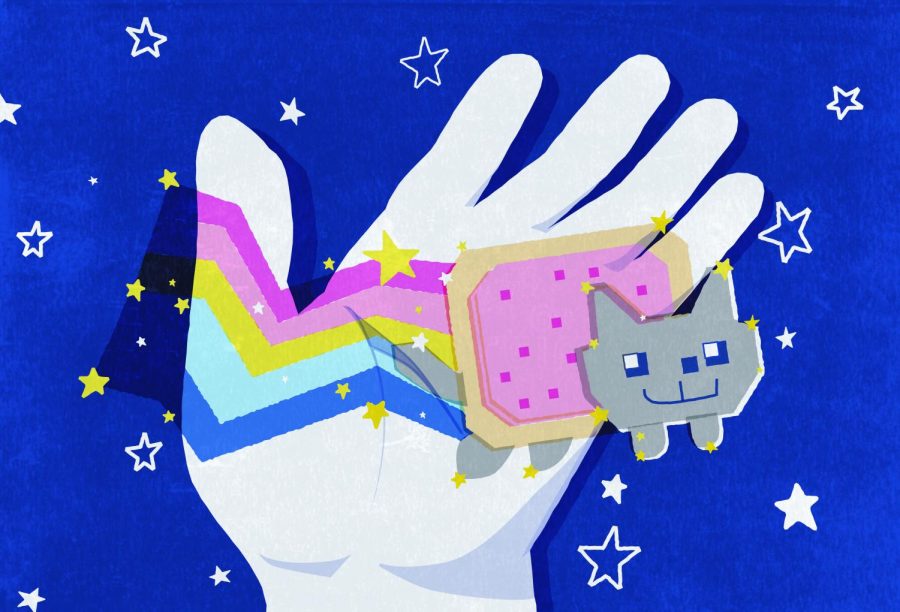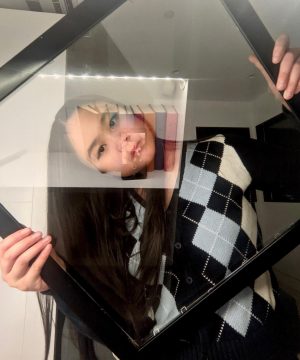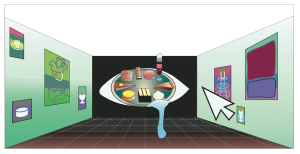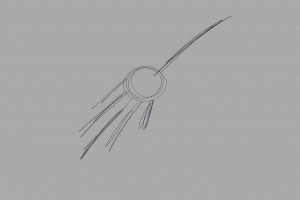In the age of crypto, we must redefine the meaning of “art”
Now, anyone in possession of a device with access to internet connection can upload their pixel images and sell them. Beauty is in the eye of the beholder and anything considered to be “art” is done so in a highly subjective manner, but rudimentary pixel art created mindlessly within the span of seconds does not fall into the category of inspiring beauty or emotional power.
April 13, 2021
What is art?
For Marcel Duchamp, it was a urinal. For Maurizio Cattelan, it was a banana taped to the wall (in an artist’s edition of 3). But for Mike Winkelman, known to the internet as “Beeple,” art has ceased to exist in a physical form — and yet it carries an even more exorbitant price tag. Duchamp’s “Fountain” artworks have cashed in at up to $2 million dollars each, Cattelan’s “Comedian” banana fetched $120,000, and Winkelman’s artwork, well, has skyrocketed into a $69.3 million dollar digital phenomenon.
The rise of the NFT, or non-fungible token, has allowed artists to sell their works directly to buyers; an NFT represents a unique address on the digital blockchain, so collectors pay a pretty penny for ownership of this address. This follows a huge spike in the crypto market in the last few years, from the rise of Bitcoin, to Ethereum, to even Dogecoin (yes, it derives its name from the famous Shiba Inu meme).
As we witness a myriad of artists from Damien Hirst to James Jean eagerly embracing crypto and creating their own NFTs, we can be sure that the art market is headed toward a decidedly blockchain-abundant future. The sale of Nyan Cat for $600,000 marks only the beginning of a new era, one where internet memes with powerful cultural legacy have become considered seriously as artwork. We’ve already seen the effects that the rise of digital platforms like Instagram have had for artists, allowing them to abandon the traditional route of securing gallery representation in order to create their work. NFTs take this type of democratization to the next level, letting artists sell their work with a simple digital upload.
Crypto art has broken a new boundary, making the buying and selling of art easier than ever. However, just because it lowers the barrier to entry doesn’t mean that low-effort pieces should count as art. While some NFTs can deliver thought-provoking and revelatory questions that add flavor to our lives, others may not. One artist has so far made $85 selling NFT farts. The simple pixel-art heads of “CryptoPunks”, consisting of a simple 24×24 pixel rectangle, sell for at least $30,000 each. So all this leaves one to wonder again – what truly is “art”?
Oxford Languages defines art as possessing a “beauty or emotional power.” The introduction of NFTs causes us to dive deeper into the fuzzy grey area that labels something as “art” by opening the floodgates to the market. Now, anyone in possession of a device with access to internet connection can upload their pixel images and sell them. Beauty is in the eye of the beholder and anything considered to be “art” is done so in a highly subjective manner, but rudimentary pixel art created mindlessly within the span of seconds does not fall into the category of inspiring beauty or emotional power. To me, a true artwork inspires a new idea that causes me to take a pause and reconsider it: an artist took the time to put thought and effort into their work, imbuing it with their own unique perspectives.
However, browsing the NFT market often begets endless scrolling, with no fascinating high-quality works that cause the viewer to pause even at the slightest. Crypto has led artwork to descend further into merely a profit-making mechanism as the NFT bubble grows bigger and bigger. Within the past few months, people have flocked to crypto with their eyes blinded by dollar signs, ignoring the integrity of artwork and simply focusing on producing as much as they can. And with this new digital platform, it’s easier than ever to over-saturate the market with unworthy pieces, often made with only a few blocky pixels, at the click of an upload. However, the new convenience of NFTs comes at a heavy cost: on average, one single NFT sale pumps out as much harmful carbon into our atmosphere as 91 paper prints. Due to the heavy carbon impact of the blockchain, our environment is suffering the brunt of the damage left by the storm of useless, underdeveloped NFT art.
In some cases, crypto art does meet the standard. Beeple’s artwork “Everydays” consists of 5,000 individual digital pieces; he created one work a day over the span of more than 13 years. While it may seem like an overwhelming and incoherent blur of tiny, colorful tiles at first glance, to me the work carries a deeper meaning that caused me to pause and reconsider it for a long time. It reveals Beeple’s evolution as not only an artist but as a person, the same human transformation that affects all of us.
Time itself becomes a key component of these 5,000 artworks. While the internet and technology have changed almost every aspect of our lives, the one thing that truly cannot be replaced is time. As we become older, we all experience new revelations, perspectives, and new life changes that can’t be replaced with the hyper-speed of the internet. Beeple’s piece took enormous self-discipline, mental and physical energy, and most importantly 13 years to develop a strong meaning. But CryptoPunks? One would have to perform complex mental gymnastics in order to find an emotional power in them.
So, we circle back again to that definition of what truly makes “art.” Duchamp’s fountain certainly triggered jarring responses from museum-goers shocked to see a urinal in a gallery, cementing its “emotional power.” The same applies to Cattelan’s duct-taped banana. And, finally, Beeple’s “Everydays” has now ascended to take its place among these powerful artworks as well.
Ultimately, the art market will only continue to grow as it explores the potential of crypto. The bubble of wealth surrounding NFTs will burst one day, but I trust that new, worthy artworks will emerge victorious amidst the masses of undeserving pixel pieces. The world would all be for the better once this stream of rushed, rapacious works dies down. I have high hopes for the new beauty and emotional power that the next generations of NFTs will inspire in us.




![LALC Vice President of External Affairs Raeanne Li (11) explains the International Phonetic Alphabet to attendees. "We decided to have more fun topics this year instead of just talking about the same things every year so our older members can also [enjoy],” Raeanne said.](https://harkeraquila.com/wp-content/uploads/2025/10/DSC_4627-1200x795.jpg)


















![“[Building nerf blasters] became this outlet of creativity for me that hasn't been matched by anything else. The process [of] making a build complete to your desire is such a painstakingly difficult process, but I've had to learn from [the skills needed from] soldering to proper painting. There's so many different options for everything, if you think about it, it exists. The best part is [that] if it doesn't exist, you can build it yourself," Ishaan Parate said.](https://harkeraquila.com/wp-content/uploads/2022/08/DSC_8149-900x604.jpg)




![“When I came into high school, I was ready to be a follower. But DECA was a game changer for me. It helped me overcome my fear of public speaking, and it's played such a major role in who I've become today. To be able to successfully lead a chapter of 150 students, an officer team and be one of the upperclassmen I once really admired is something I'm [really] proud of,” Anvitha Tummala ('21) said.](https://harkeraquila.com/wp-content/uploads/2021/07/Screen-Shot-2021-07-25-at-9.50.05-AM-900x594.png)







![“I think getting up in the morning and having a sense of purpose [is exciting]. I think without a certain amount of drive, life is kind of obsolete and mundane, and I think having that every single day is what makes each day unique and kind of makes life exciting,” Neymika Jain (12) said.](https://harkeraquila.com/wp-content/uploads/2017/06/Screen-Shot-2017-06-03-at-4.54.16-PM.png)








![“My slogan is ‘slow feet, don’t eat, and I’m hungry.’ You need to run fast to get where you are–you aren't going to get those championships if you aren't fast,” Angel Cervantes (12) said. “I want to do well in school on my tests and in track and win championships for my team. I live by that, [and] I can do that anywhere: in the classroom or on the field.”](https://harkeraquila.com/wp-content/uploads/2018/06/DSC5146-900x601.jpg)
![“[Volleyball has] taught me how to fall correctly, and another thing it taught is that you don’t have to be the best at something to be good at it. If you just hit the ball in a smart way, then it still scores points and you’re good at it. You could be a background player and still make a much bigger impact on the team than you would think,” Anya Gert (’20) said.](https://harkeraquila.com/wp-content/uploads/2020/06/AnnaGert_JinTuan_HoHPhotoEdited-600x900.jpeg)

![“I'm not nearly there yet, but [my confidence has] definitely been getting better since I was pretty shy and timid coming into Harker my freshman year. I know that there's a lot of people that are really confident in what they do, and I really admire them. Everyone's so driven and that has really pushed me to kind of try to find my own place in high school and be more confident,” Alyssa Huang (’20) said.](https://harkeraquila.com/wp-content/uploads/2020/06/AlyssaHuang_EmilyChen_HoHPhoto-900x749.jpeg)
















Jin Tuan • Apr 21, 2021 at 3:08 pm
A wonderful, thought-provoking piece, Michelle! I’d suggest also looking into Kevin Abosch’s work, which sparked a similar rage in myself as well (his personality didn’t help his case much either haha). Examples include his one million dollar potato photo and his 2018 “Forever Rose,” which is also a piece of crypto art consumed through NFTs.
You were right in saying that art is highly subjective. If an artist’s intentions are unknown, what might have been considered a groundbreaking piece could be misconstrued as flotsam. Who decides what is art and what isn’t? That’s still a question that I struggle over as well. Is it the audience, or the creator?
Now, which one is the artist? I’ll get back to this later.
Andy Warhol adopted silk-screening to be able to reproduce his motifs more easily on a large scale. Compared to hand painting each detail on each piece, I’d argue that his new method took much less effort. In fact, he said as much himself, as his quote in his eponymous 1968 catalogue perfectly summarizes.
“I tried doing them by hand, but I find it easier to use a screen. This way, I don’t have to work on my objects at all. One of my assistants or anyone else, for that matter, can reproduce the design as well as I could.”
And yet, we still consider his prints art. Sometimes, it takes years or decades for us, the audience, to reassess something and call it art. Other times, it’s forgotten forever, remembered only vaguely by the consciousness of the creator who could have already died long ago, their energy dissipating into the surrounding universe. But I digress.
CryptoPunks may not have been difficult to make, but I have to question what differentiates these pixels from Warhol’s prints. The creation of these little heads took coding prowess and a basic grasp of design, and each of the 10,000 is still unique in its own way. Even if no one sat and drew each one out by hand, a different set of skills was necessary to create the NFTs.
Perhaps, with that argument, CryptoPunks passes the art standard, but that doesn’t excuse the rest of the storm you mentioned.
Okay, dance break. Record scratch. Freeze frame. Rewind. My questions earlier on were, who defines what is art? Is it the creator or the audience? Who, then, is the artist?
I’d say it’s whoever defines a piece as art. Then they become a creator. Interpretation is generative, and an audience is never passively absorbing their surroundings. It’s a very circular definition, but I like it that way to keep accidental or observational art in mind.
Honestly what I just wrote sounds confusing to me too, but bear with me here. Let’s say that someone spits gum onto the sidewalk, and someone else steps on it, curses, and walks away, leaving the pink, dirty blob in a spiky heart shape. The two people, Gum Spitter and Gum Stomper, are the creators of the piece. But the artist would be you, who walks by and focuses on this. You, the audience, reflecting on such a coincidence, imbue the scenario with emotional power. You become the artist, despite not being the creator of the original piece.
What does any of this this have to do with the McFlurry of useless crypto art polluting the Earth, though? I think my ramblings all come together like a wet ball of sand here.
First, despite how trash-like some of these NFTs may seem, we will never know the full intention of the creators if they don’t tell us. Some really may be looking to earn a quick buck, but others may be making bad crypto art with an archness that differentiates it from its brethren, though they may look the same. They may be making it as a social experiment type of deal, watching people trip over themselves to spend money on something they themselves as creators have deemed useless garbage.
Second, let’s switch reference frames real quick. Some of this crypto art is trash. Some of it isn’t. What’s clear is that it’s a trend, and NFTs are flooding the new art market. But isn’t the discourse around crypto art and the raging controversy enough to cement its status as art? I’d argue that your anger and frustration is proof enough that this crypto art, regardless of its composition, holds emotional power. You’ve made art out of this situation, and so looking past all the little individual pieces of the puzzle, this non-fungible fiasco has, in a way, become a disastrously beautiful work of art in your eyes — a monster of communal creation, unity under the flag of greed — whatever it is, it’s worth something to you now. And so each little piece is artistically worth something, too.
So. What is art, truly?